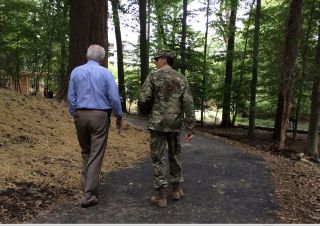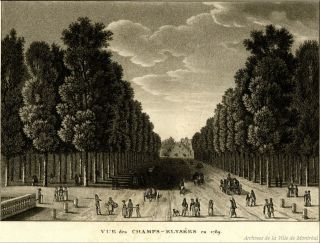Stress
Lift Your Mood With Exercise Without Getting on a Treadmill
Walk 30 minutes daily to reduce stress, sleep well, and improve your mood.
Posted January 2, 2024 Reviewed by Abigail Fagan
Key points
- Moving more during the day reduces evening stress and improves mood.
- Walking 30 minutes daily plus a healthy diet and meditation can reverse stress-induced chromosome shortening.
- Prolonged sitting is associated with many illnesses, while taking short movement breaks improves health.

Are you feeling groggy after the holidays? Dreading your New Year’s resolution to exercise every day? It’s great if you’re a person who loves to jog, run marathons, or run on the treadmill. But what if you’re not? What if you just can’t motivate yourself to break a sweat—or if your joints and muscles don’t allow you to do it? There are many ways to move and get the benefits of exercise without even trying and have fun doing it.
Moving is important for many aspects of health, beyond boosting your flagging energy. The expression “Sitting is the new smoking” is very true. Prolonged periods of sitting are associated with greater risks for heart disease, diabetes, depression, anxiety, even cancer and cognitive risks: the brain's memory centers are shrunk in people who chronically sit for prolonged periods.
So, anything you can do to reduce the length of time you sit—like interspersing periods of movement with shorter periods of sitting—and any way you move more, whether walking from the parking lot to the grocery store, moving about your workplace, or taking a walk in the neighborhood, will be beneficial. Movement can give you a boost of energy when you’re fatigued, help you relax when you are anxious or stressed, and even prime you for creativity.
In our studies in which we fitted government office workers with wearable health tracking devices and measured their movement and stress responses during two and a half days, we found that people in open office settings were 32 percent more active than those in private offices and 20 percent more active than those in cubicles. That’s 1,000 steps more per day—your office could be your new gym! And those who were more active during the day were less stressed at night, slept better and were in a better mood the next day.
The spaces we studied were purposefully designed to provide many options for employees: bench seating where workers had their workstations, small private phone rooms, medium- and large-size conference rooms, a roof deck with café tables, and so on. Intentionally designing attractive spaces optimized for specific purposes will entice people to work in them and in turn to move their bodies to get to them.
Uninviting spaces, on the other hand, will keep people glued to their chairs. One worker described how the dark, dingy, windowless lunchroom at one of her previous workplaces remained perpetually empty, as no one wanted to walk the couple of flights down to eat in it and instead ate at their desks. And it didn’t help that the stairwell leading to the lunchroom was also dingy, dimly lit, and just wide enough to climb up or down in single file. In fact, research shows that brightly lit staircases, wide enough for people to stop and chat or even with spaces to sit, can help encourage walking between floors instead of riding the elevator.
The Caltrans District 7 Headquarters building in downtown Los Angeles is a structure whose design invites movement—very fitting for an organization that manages movement across one of the busiest transportation hubs in the world. The building's central atrium, bathed in light from rooftop skylights sports a spectacular staircase with glass panel railings that naturally invites people to climb it. The brightly lit central atrium that pierces every floor also inspires movement. When I visited, a group of workers in one of the open office seating areas surrounding the atrium had put on their sneakers to walk around the “track” during their lunch break, so inviting was the brightly lit circular space on every floor.
Consciously programming in movement breaks during the day can also encourage people to get up and move. I visited a teddy bear factory in Vermont where every hour or so, lively music played over the loudspeaker, signaling to workers that they could stand up and stretch and even throw in a few dance moves, to relax for a moment away from their sewing machines. You can do this for yourself, by programming your smartphone to play a favorite dance tune every hour or so while you work.
A guided nature trail at the Mayo Clinic in Scottsdale, Arizona is an ADA-accessible, stroller-friendly path, so popular that hospital staff, patients’ family members, and even people living in the surrounding neighborhoods go out of their way to use the trail whenever they have a few moments in the day.
At the Walter Reed National Military Medical Center in Bethesda, Maryland our team worked with Navy personnel to retrofit a forest glen path along a stream that winds through that military base. When the forest glen—we called it the “Green Road”—was completed, its picnic area and music circle along the newly ADA-accessible path beckoned people to walk, in contrast with the nearby urban road that discouraged walking. Those who used the path reported feeling calmer, happier, and less stressed compared to when they walked along the urban road.
These findings provided clear evidence that walking in nature is beneficial not only for movement but also for overall well-being. This was not surprising since other research shows that gentle exercise enhances brain endorphins and feel-good dopamine pathways.

Tumamoc Hill is a popular hiking spot in downtown Tucson, Arizona. Rising more than 3,000 feet above the desert floor, it is the oldest desert sanctuary and research station in the world and a treasured archeological site, containing evidence of agriculture dating back over 4,000 years. Its steep and narrow path that winds up to the top of the hill from the city street below, attracts hundreds of walkers all year round, from sunrise to sunset. People go there to exercise, to watch the sun rise or set over the desert and surrounding mountains, to socialize with friends and family, to decompress after a hard day’s work, or to start the day with a sense of calm. Many of the staff from the nearby hospital reported that taking a walk up the hill between or after long shifts helped them stave off stress and burnout during the depths of COVID.
In cities where such walkable green spaces don’t exist, urban planners are beginning to turn previously blighted, abandoned empty spaces or old industrial plots into parks. Los Angeles’s urban planning commission, for example, has systematically created a string of parks, including one in what had once been a Gold Rush–era warehouse district of LA. Situated between the LA River and the Elysian Heights neighborhood, the park now offers workers in nearby businesses a green space in which to re-energize.

The idea that city parks are good for public health is not new. France’s King Louis XIV was the first European king to envisage a city surrounded by an avenue of trees instead of a wall. He created gardens accessible to all, connected by wide esplanades, purposefully designed to encourage people to walk among them. The widest thoroughfare was one that connected the Tuileries Garden to the city outskirts and large tree-filled fields. Those fields, or "champs" in French, reminded the planners of the Greek gods’ paradise, called Elysium, so they called the space the Elysian Fields, or Champs-Élysées. By the early eighteenth century, visitors to Paris remarked that strolling along the city’s tree-lined streets was good for one’s health. Today, of course, the Champs-Élysées is no longer a forested park but that wide avenue that remains an iconic symbol of Paris—one of the most walkable cities in the world!
So, to improve your mood and your health, get out and walk! All you need is 30 minutes of walking a day to stay healthy. Research shows that combining that 30 minutes with a healthy Mediterranean diet and mindfulness meditation three times per week can reverse the shortening of chromosomes brought on by chronic stress. Find a place to walk in your neighborhood, in a local park, around your office, or make a point of parking farther from your destination. You’ll be surprised how quickly the steps add up, without you even realizing it, and how, in the process your mood lifts and your health improves!
References
Excerpted and condensed from Sternberg, E.M. (2023) Well at Work: Creating Wellbeing in Any Workspace Little, Brown Spark NY.
Ameli, R., Skeath, P., Abraham, P. A., Panahi, S., Kazman, J. B., Foote, F., ... & Berger, A. (2021). A nature-based health intervention at a military healthcare center: A randomized, controlled, cross-over study. PeerJ, 9, e10519.
Boecker, H., & Dishman, R. K. (2023). Physical activity and reward: the role of endogenous opioids. In Routledge handbook of physical activity and mental health (pp. 57-70). Routledge.
Kelly, P., Williamson, C., Niven, A. G., Hunter, R., Mutrie, N., & Richards, J. (2018). Walking on sunshine: scoping review of the evidence for walking and mental health. British journal of sports medicine, 52(12), 800.
Levine, J. A. (2014, August). The chairman’s curse: lethal sitting. In Mayo Clinic Proceedings (Vol. 89, No. 8, pp. 1030-1032). Elsevier.
Ornish, D. (2022). A new unified theory of lifestyle medicine. Int. J. Dis. Reversal an Prev, 4, 1-5.
Ornish, D., Lin, J., Chan, J. M., Epel, E., Kemp, C., Weidner, G., ... & Blackburn, E. H. (2013). Effect of comprehensive lifestyle changes on telomerase activity and telomere length in men with biopsy-proven low-risk prostate cancer: 5-year follow-up of a descriptive pilot study. The lancet oncology, 14(11), 1112-1120.
Soares-Miranda, L., Imamura, F., Siscovick, D., Jenny, N. S., Fitzpatrick, A. L., & Mozaffarian, D. (2015). Physical activity, physical fitness and leukocyte telomere length: the cardiovascular health study. Medicine and science in sports and exercise, 47(12), 2525.




